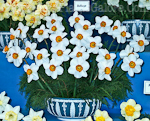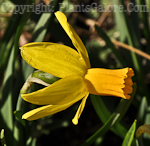|
|
|
 |
|
 |
 Narcissus, and more specifically
daffodils, are second only to tulips
in the number of bulbs grown in home
landscapes. The genus name,
Narcissus, includes several
different types of bulb plants.
Technically, what we call daffodils
are only the ones with trumpet like
flowers. Jonquils are those in
Division 7 below and are from a
small number of species including
N. jonquillia
and N.
juncifolius. A handful of other
species in the genus are just called
narcissus. Narcissus, and more specifically
daffodils, are second only to tulips
in the number of bulbs grown in home
landscapes. The genus name,
Narcissus, includes several
different types of bulb plants.
Technically, what we call daffodils
are only the ones with trumpet like
flowers. Jonquils are those in
Division 7 below and are from a
small number of species including
N. jonquillia
and N.
juncifolius. A handful of other
species in the genus are just called
narcissus.
 Traditionally, there has been a lot
of confusion about the different
types of plants included in the
genus, Narcissus. The Royal
Horticultural Society in
England
decided to develop a classification
system to clear up the mess. In
1949, they issued their system which
divides all the members of the genus
into 11 Divisions. Traditionally, there has been a lot
of confusion about the different
types of plants included in the
genus, Narcissus. The Royal
Horticultural Society in
England
decided to develop a classification
system to clear up the mess. In
1949, they issued their system which
divides all the members of the genus
into 11 Divisions.
Divisions 1 to 9 are all plants of
garden origin. That means that it
does not include actual species but
plants developed from these species.
Some of the Divisions are based on
color patterns of the perianth and
corona while others include size and
shape criteria.
BTW -
In Latin, the plural of narcissus
would be narcissi. However, the
American Daffodil Society has
decided that its members may use
the word, narcissus for both the
singular and plural.
|
|
 |
- Div 1 - Trumpet
Narcissus
- Div 2 - Large
Cupped Narcissus
- Div 3 - Small
Cupped Narcissus
- Div 4 - Double
Narcissus
- Div 5 - Triandus
Narcissus
- Div 6 -
Cyclamineus
Narcissus
|
|
|
|
 |
 Narcissus and
Daffodil Varieties - This
popular plant has lead to the
development of thousands of
cultivated varieties i.e. cultivars.
Each years many more named cultivars
appear on the market and it would
take a real devotee to keep track,
let alone grow, all of them. Narcissus and
Daffodil Varieties - This
popular plant has lead to the
development of thousands of
cultivated varieties i.e. cultivars.
Each years many more named cultivars
appear on the market and it would
take a real devotee to keep track,
let alone grow, all of them.
Included in the Division sections
below are examples of several
cultivars which fit the definition
of that grouping. Of course, there
are probably hundreds more that
could be divided into each
category...if only we had the time
to compile the list.
BTW -
There is also a
classification system for
daffodils only.
|
|
|
|
|
 |
|
|
  |
One flower to a stem with the
trumpet or corona as long or longer
than the perianth segments (petals
surrounding the corona).
|
|
 |
 -
Yellow -
Yellow |
Perianth is colored yellow and corona
also colored yellow but is NOT a paler
shade
than the perianth.
|
 |
- 'Bastion'
- 'Cromarty'
- 'Dutch Master'
- 'Explorer'
- 'Golden Harvest'
- 'King
Alfred'
- 'Kingscourt'
|
- 'Magnificence'
-
'Rembrandt'
- 'Standard Value'
-
'Unsurpassable'
- 'Yellow Triumphator'
-
'William the Silent'
|
|
 |
 -
Bicolor -
Bicolor |
Perianth is white and the corona
another color.
|
 |
- 'Foresight'
- 'Magnet'
- 'Trousseau'
- 'World's Favorite'
|
- 'Preamble'
- 'Bambi'
- 'Music Hall'
- 'Queen of the Bicolors'
|
 |
 -
White -
White |
Perianth is white and the corona
is white but NOT paler white than
the perianth.
|
 |
- 'Beersheba'
- 'Broughshane'
- 'Cantatrice'
- 'Matterhorn'
|
- 'Mount Hood'
- 'WP Milner'
- 'Roxane'
|
 |
 -
Other Combinations -
Other Combinations |
| |
 |
'Spellbinder' - (perianth sulphur yellow,
corona sulphur yellow outside, white inside)
'Rushlight' - (lemon yellow perianth, white
corona edged in yellow) |
 |
 |
|
|
  |
Distinguishing Characteristics:
One flower to a stem with the corona
being more than one-third, but not
equal to, the length of the perianth segments.
|
 |
 Yellow Yellow |
Distinguishing Characteristics:
Perianth is yellow and the corona
is yellow but NOT paler colored than the perianth.
|
 |
- 'Aranjuez'
- 'Armada'
- 'Bermuda'
- 'Carbineer'
- 'Carlton'
- 'Ceylon'
|
- 'Fortune'
- 'Galway'
- 'Madeira'
- 'Narvik'
- 'Nimrod'
- 'Scarlet Elegance'
|
 |
 Bicolor Bicolor |
Distinguishing Characteristics:
Perianth is white and the corona
is another color.
|
 |
- 'Alayne'
- 'Dick Wellband'
- 'Duke of Windsor'
- 'Flower Record'
- 'John Evelyn'
- 'Kilworth'
- 'Mrs. R.0. Backhouse'
- 'Nissa'
|
- 'Pink Beauty'
- 'Pink Fancy'
- 'Pink Rim'
- 'Professor Einstein'
- 'Roseworthy'
- 'Salmon Trout'
- 'Selma Lagerlof'
- 'Walt Disney'
|
 |
 |
Distinguishing Characteristics:
Any color combination not
falling into above Divisions.
|
 |
- 'Binkie', (perianth sulphur
yellow, corona sulphur yellow
turning to white)
- 'Charter', (perianth
primrose yellow with white base,
corona cream tinged yellow)
- 'Daydream', (penianth
yellow, corona white)
- 'Handcross', (perianth
dresden yellow, corona pale
yellow)
|
 |
 |
|
|
 |
|
|
  |
Distinguishing Characteristics:
Flowers are double. Approximate
time of bloom: mid-season.
|
 |
- 'Cheerfulness' (white)
- 'Cheerfiuiness Primrose'
(primrose-yellow)
- 'Golden Ducat' (yellow)
- 'Mary Copeland' (white with
orange-red cup)
- 'Tahiti' (yellow
interspersed with segments of
saturn-red)
- 'Texas' (yellow interspersed
with yellow and red)
- 'White Lion' (white with
straw yellow segments)
- 'White Marvel' (white)
|
 |
 |
|
|
 |
|
|
  |
Distinguishing Characteristics:
Characteristics are similar to
the species,
Narcissus cyclamineus, which
is the dominant parent used in
developing cultivars for this
Division. The perianth segments
bend backwards and the corona is
long, cylindrical and
serrated at the edge. Stems grow
to about 6-10 inches
tall and usually bear one flower
each.
Approximate time of bloom: early
season.
|
 |
 |
Distinguishing Characteristics:
The cup or corona is at least
two-thirds the length of the perianth
segments or longer.
|
 |
|
|
|
 |
|
|
 |
|
 |
 |
|
|
  |
White perianth with very flat, short,
lemon-colored cups, rimmed
orange or scarlet.
Distinguishing Characteristics:
Have characteristics similar to
the species,
Narcissus poeticus, which is
a key parent to the cultivars in
this Division. The solitary,
fragrant flowers are borne atop
narrow, blue green foliage.
Flowers have a white perianth
and a small saucer shaped corona
that is pale yellow, edged in
red and are called Pheasant's
Eyes. Approximate time of bloom:
late season.
|
 |
|
|
 |
 |
|
|
  |
Distinguishing Characteristics:
This group includes Narcissus
species, their wild forms and their
cultivars that are not of garden
origin. These are types only
found in nature and have not
been hybridized by humans.
|
- N. buibocodium
- N. juncifoiius,
- N. iobuiaris
|
- N. minimus
- N. triandrus var. aibus
- N. Watieri
|
|
Narcissus bulbocodium
- Hoop Petticoat Daffodil - The
plants 3 or 4 rush-like leaves
with are
8 inch stems. They have bright
yellow flowers with a perianth
that consists of narrow segments
and a cup that is widely
expanded which resembles a
petticoat. They are native to Southern Europe to
Morocco.
Zones 6-9
|
 |
- var. citrinis
has lemon-yellow
blossoms
- var. conspicuous
is the latest to
bloom and produces
deep golden-yellow
flowers
- 'Tenuifolius'
bears a 6 lobed,
wide yellow corona
above thin
thread-like leaves
|
| Related species: |
- N. cantabricus
- Cantabrian
Daffodil - They bear fragrant white
“petticoat” flowers in early
spring. Only one leaf is formed. Sometimes
sold as N. bulbocodium var.
monophyllus.
- N. x
romieuxii
- A tetraploid
which is
probably the result of N.
bulbocodium
x N. cantabricus.
The sulphur yellow “petticoat”
flowers are the first yellow
daffodils to emerge in the
spring.
|
| |
|
|
- Narcissus
canalieulatus - Chinese Lily Narcissus
- They
are 6-9 inches tall bearing four
to six flowers per stem that
each have a white perianth and a
yellow cup . They are
native to Southern France. Zones
6-9
Related species:
|
- N. nanus - These
are dwarf daffodils that
only grow to 6- 8 inches
with small, white, fragrant
flowers that have yellow
cups. They are sometimes sold as
N. lobularis.
- N. obvallaris -
Tenby Daffodil - They have 12 inch long stems that are topped
with golden yellow flowers with
a long yellow, green-tinged cup.
|
 |
 |
|
|
  |
Distinguishing Characteristics:
Daffodils which do not fit in
any of the above Divisions.
|
|
|
|
|
 |
 |
Distinguishing Characteristics:
The corona of the flowers is
split for at least
one-third its length. They are
also referred to as Collar and Papillon
(butterfly) Daffodils.
|
 |
- 'Cassata'
- 'Dolly Moillnger'
- 'Firestreak'
- 'Orangery'
|
- 'Mol's Hobby'
- 'Papiillon
Blanc'
- 'Pink Supreme'
|
|
|
|